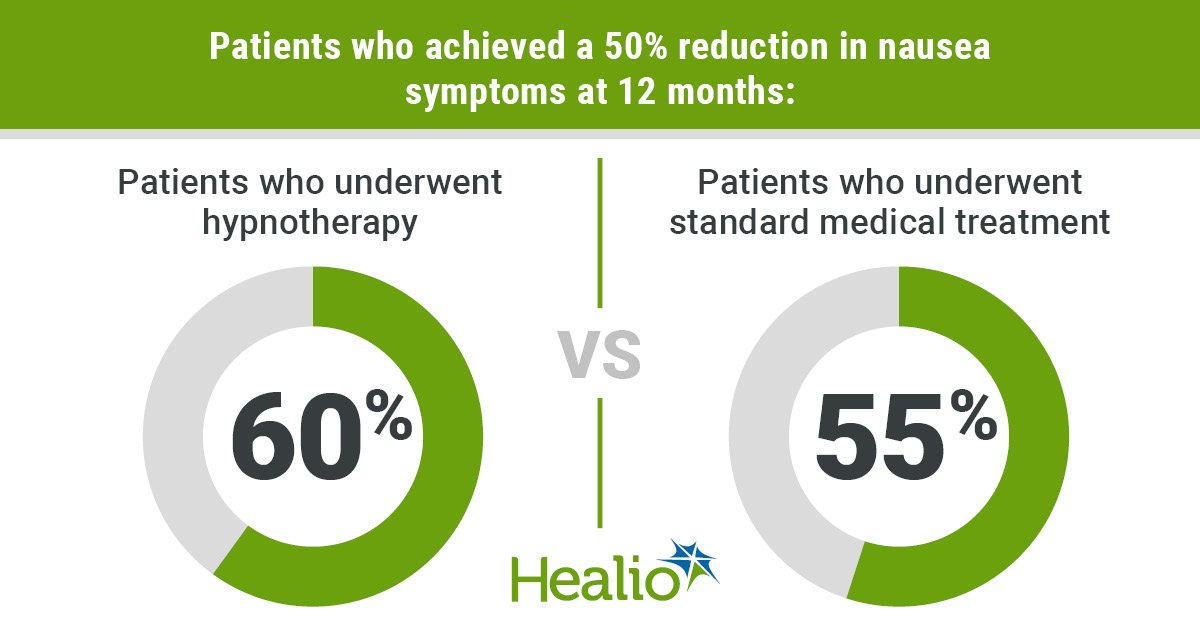August 9, 2022
2 min read
Studies have shown that both hypnotherapy and pharmacotherapy, combined with psychological support, reduced symptoms of chronic nausea in pediatric patients with functional nausea and functional dyspepsia.
“treatment of [functional nausea] With a lack of published treatment trials for chronic nausea, treatment is challenging and generally based on empirical strategies. … Previous studies suggest that hypnotherapy may be a promising treatment option targeting the etiological biopsychosocial factors of chronic nausea.” Pamela D. Brown, M.D., Ph.D. Researchers from the Departments of Paediatric Gastroenterology, Hepatology and Nutrition at Emma Children’s Hospital in Amsterdam said: Clinical Gastroenterology and Hepatology“By instinct [hypnotherapy] It is highly effective in adults and children with functional abdominal pain and irritable bowel syndrome. …To the best of our knowledge, [hypnotherapy] “For children with chronic nausea”

In a randomized controlled trial, Brown and colleagues evaluated 100 pediatric patients (mean age 14.7 years, 73% girls) who met the Rome criteria for functional nausea (FN, 65%) or functional dyspepsia (FD, 35%). Patients received either hypnotherapy (HT), consisting of six 50-60 minute sessions over a 3-month period, or standard of care (SMT), consisting of six visits to a pediatrician and six 30 minute sessions of supportive care over a 3-month period. If treatment was not successful at 3 months, children could begin a co-intervention that included HT or cognitive behavioral therapy.
The primary endpoint was at least a 50% reduction in the severity, incidence, or frequency of nausea after 12 months, and secondary endpoints included improvement in abdominal pain, dyspeptic symptoms, and health-related quality of life. Children were asked to rate their nausea symptoms in a 7-day diary, and researchers assessed outcomes at baseline, midpoint, post-treatment, and at 6- and 12-month follow-up.
Immediately after treatment and at 6-month follow-up, patients in the HT group had a higher treatment success rate compared with the SMT group (45% vs. 26% and 57% vs. 40%, respectively). At 12 months, similar treatment success rates were reported in both groups (60% vs. 55%).
The researchers noted that patients with FN who received HT had higher success rates during (40% vs. 13%) and after treatment (50% vs. 23%), but success rates did not differ among patients with FD who received HT. Furthermore, younger age was associated with higher success rates at 12-month follow-up (OR = 0.8; 95% CI, 0.652-0.982), although the differences between intervention groups were not significant.
The researchers further reported that patients in the HT group had a higher rate of adequate relief at 6 months (81% vs. 55%) and their parents (79% vs. 53%), but this measure was not significant at 12 months between patients (70% vs. 66%) and parents (72% vs. 57%).
Thirteen patients in the HT group and 15 in the SMT group began joint intervention, and at 12 months of follow-up, treatment success rates increased to 62% in the modified HT group and 52% in the SMT group.
“This study showed that both hypnotherapy and pharmacotherapy, combined with supportive therapeutic discussion and education, were effective in reducing symptoms of chronic nausea in children diagnosed with FN or FD. HT was more effective especially in the group of children with FN during the first 6 months after treatment,” Brown and colleagues concluded. “Based on these results, we recommend that both pharmacotherapy and HT, either individually or in combination, be applied as potential treatments for chronic nausea, in line with a shared decision-making approach, and discussed with children and parents at consultations.”

